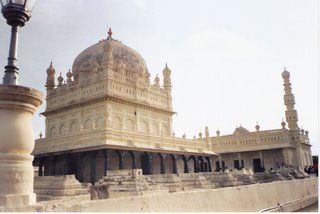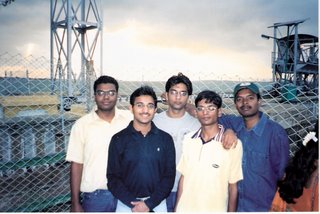MYSORE city is in state of Karnataka, India and has been the capital of Central South India since medieval times, before Bangalore took over a few decades back. The warriors: Hyder Ali and his son Tipu Sultan waged war against Britain’s East India Co. from nearby Srirangapatnam township in 19th C and a long line of Wadeyar kings to this date have been based in Mysore. The city is known for silk, metallic and leather handicrafts and chandan (sandal) based toiletries and cosmetics. The city has the ideal blend for swarming tourists – palaces, temples, forts, museums, galleries and nearby bountiful avenues into nature.
14 August 2005 : The six of us - Ashish, Hitesh, Nishant, Rajat, Sarvadaman and myself - Mohit, could not have chosen a more crowded week-end (Monday being the Independence Day) and yet could have had a more eventful day perhaps. We boarded the Bus-116 from our Infosys Mysore campus at 07:50 and reached the city at 08:40. Despite most taxis already booked, we managed to arrange a taxi with an agent. The driver Jamaluddin knew English, Hindi and Kannada but the taxi did not have a stereo system. The deal was fixed for Rs. 800 .
14 August 2005 : The six of us - Ashish, Hitesh, Nishant, Rajat, Sarvadaman and myself - Mohit, could not have chosen a more crowded week-end (Monday being the Independence Day) and yet could have had a more eventful day perhaps. We boarded the Bus-116 from our Infosys Mysore campus at 07:50 and reached the city at 08:40. Despite most taxis already booked, we managed to arrange a taxi with an agent. The driver Jamaluddin knew English, Hindi and Kannada but the taxi did not have a stereo system. The deal was fixed for Rs. 800 .
Chamundi (Goddess Kali) Hill Temple - 8 km
This revered hill-temple majestically overlooks the Mysore city. It is usually over-crowded in mornings and this week-end being what it was.... .... well, we parked 1.5 km away and had decided to do with only the temple’s parikrama (circumambulation), when the idol of Chamundi Devi seated on a small chariot was brought out of temple just as we stood there. Blessed that we had this unique darshan (divine glimpse), we took the snaps and proceeded back. A beautiful colorful statue of demon Mahishasura (was slained by the goddess, and after which the city is named - Mysore) is there in front of the Temple. Snap. A packet of ripened 50 ripened red berries was timely.
Nandi (Carrier of Lord Shiva) Bull Statue – 0.5 km down the slope

The return-trip is invariably via the Nandi Bull - A huge 4 m. high and 5 m. long black Monolithic structure. There is also a flight of 1000-step stairs from the base of the hill up to the temple via the Nandi Bull statue. Of this size, there are only 5 or 6 Bulls in South India and I had seen one at Bangalore as well.
Maharajah's Palace : Amba Vilas Durbar - 0 km.
Belonging to the Wadeyar Rajahs, the Amba Vilas Durbar is the crowning glory of Central South India. The murals are richly decorated and every inch of the wall is colored or gilded. Doors and roof-tops are of carved wood and western colored glasses and mosaics adorn the palace throughout its two storeys accessible to public view. The building built by a western architect in early 20th Century is all stone, with several tall minarets featuring Roman Arches, gilded panels and bright red domes. It features the portraits of many of its rajahs, paintings of foreign dukes and ceremonial processions and events like the coronations, wedding and world-famous famous Dushera festival of Mysore.
The museum, I could not visit - but contains the armaments and attires and the furniture of Ranis and Rajahs. There are also camel and elephant rides to be enjoyed. Outside there are curio-handicraft shops.
Sri Jaichamrajendra Art Gallery: 2 km
This palace-turned-Art gallery contains beautiful clocks esp. The French Musical Clock, Japanese Paper-craft painting, painted bone china cutlery, musical instruments (3rd floor), royal paintings of Tipu Sulatn and Wadeyars rajahs, landscapes of Tibet, Ladakh and Himalayas by several artists, Mughal & Rajasthani miniature paintings, and as always the portraits of mythical feminine subjects. India’s most well-known artist Raja Ravi Verma's paintings rivet you: Lord Rama & Lankan Sea; Lady in moonlight, Wadeyar portraits and above all the masterpiece - the mystical "Lady with the Lamp"!
There is also a government sandal shop - Cauvery, inside the gallery containing incensed sticks, powders, oils, scents etc. The private ones outside with similar names sell thestuff at a discount but the quality is doubtable.
Zooligical Park: 2 km. The best in South India
The variety of animal kingdom is awe-inspiring:
Lions, Royal Bengal and White Tigers, panthers, and leopards;
Giraffes, hippopotamus, Asian & African bisons, bears, zebras, deers and blackbucks;
Lemurs, macaques, chimps; Various types of snakes - cobra, rattle, rat and vipers;
Various pheasants, flamingoes, peacocks; Giant Squirrel;
Alligators and crocodiles, and aquarium and what not.
This zoo feature certain animals not featured elsewhere in India: African elephants, Gorillas and Tapis! It is clear that despite all the affectations of security and enclosures, it is the fact that animals have become habituated and 'territorially reserved' which prevents them from venturing out of their enclosure and shutting Mysore down.
Lunch was a fantastic North Indian (Dishes 60, Rotis 20 each) affair in Hotel Viceroy (Rs.500)
Lunch was a fantastic North Indian (Dishes 60, Rotis 20 each) affair in Hotel Viceroy (Rs.500)
St. Philomena's Church
It was seen on the way and it is a huge stone Roman structure and one of the largest in the region.
SRIRANGAPATNAM township: 15- 18 km from Mysore
Daria Daulat Bagh: Royal gardens of Tipu Sultan
There is a small museum at the centre of the manicured lawns. The mundane outside appearance belies the eye-popping mural paintings inside, depicting the defeat of the East India Company’s army by Tipu Sultan, the warrior king in First Anglo-Mysore War (late 19th C).

There are also the royal sofas, maps, landscapes of forts, burials, peaks and valleys by British painters published in London papers way back in 18th C. Also are the pencil sketches of Tipu's seven sons and his closest warriors and personal aides - again by foreign painters. Photography is prohibited.
Tipu and his father Haider Ali (late 18th C) consolidated the State of Mysore, checked the Nizams and Marathas both and using the latest French technology, made Britisher's existence dreadful across Central South India. Even the Wadeyars owed allegiance to them till Tipu was defeated by the treachery of his minister Mir Qasim, and killed in 1799.
Tipu's Fall – the place where Tipu Sulatn’s dead body was found.
 Gumbaj – is a large white tomb where Tipu Sultan and his parents are buried. The structure has a big onion-shaped dome. There are also the graves of the clansmen and close aides.
Gumbaj – is a large white tomb where Tipu Sultan and his parents are buried. The structure has a big onion-shaped dome. There are also the graves of the clansmen and close aides.
Sangam (Confluence): 2 km from Gumbaj, is a serene spot where Kaveri meets another river. Nice cheap coconuts and their butters to be relished here and boating to be done in local round-pan boats made of thatched leaves and wood.
Sri Ranganathswamy temple, fortress and Dungeon of Srirangapatnam are other worthwhile places to be seen but we were in hurry.
 Gumbaj – is a large white tomb where Tipu Sultan and his parents are buried. The structure has a big onion-shaped dome. There are also the graves of the clansmen and close aides.
Gumbaj – is a large white tomb where Tipu Sultan and his parents are buried. The structure has a big onion-shaped dome. There are also the graves of the clansmen and close aides.Sangam (Confluence): 2 km from Gumbaj, is a serene spot where Kaveri meets another river. Nice cheap coconuts and their butters to be relished here and boating to be done in local round-pan boats made of thatched leaves and wood.
Sri Ranganathswamy temple, fortress and Dungeon of Srirangapatnam are other worthwhile places to be seen but we were in hurry.
Krishnasagar (KRS) Dam: Detour from Srirangapatnam and 19 km from Mysore.
Built as a small masonry structure by Tipu on Cauvery River, it was greatly improved by Sir Vishvesharaiyya, the renowned Bharat Ratna recipient engineer. It is to be reached by stopping the car 3 km from famous Brindavan garden on the KRS Road and traveling a rural road straight for half a km. to the dam. Once there, we along with a crowd of over a 500 people (growing with the evening) witnessed the scene of release of Cauvery River and of its large reservoir behind it where annually on Dushera Festival, the water sports take place.
Once there, we along with a crowd of over a 500 people (growing with the evening) witnessed the scene of release of Cauvery River and of its large reservoir behind it where annually on Dushera Festival, the water sports take place.
Built as a small masonry structure by Tipu on Cauvery River, it was greatly improved by Sir Vishvesharaiyya, the renowned Bharat Ratna recipient engineer. It is to be reached by stopping the car 3 km from famous Brindavan garden on the KRS Road and traveling a rural road straight for half a km. to the dam.
 Once there, we along with a crowd of over a 500 people (growing with the evening) witnessed the scene of release of Cauvery River and of its large reservoir behind it where annually on Dushera Festival, the water sports take place.
Once there, we along with a crowd of over a 500 people (growing with the evening) witnessed the scene of release of Cauvery River and of its large reservoir behind it where annually on Dushera Festival, the water sports take place.Brindavan garden : Series of musical fountains: 2 km from KRS Dam
The Brindavan garden’s musical fountains come alive in the evening (and in this extended weekend, large crowds had gathered from far away towns and certain unruly scenes occurred too.)
At the entrance of the garden, there is a 400 m. narrow bridge over an artificial lake.The Garden has many small and big, illuminated and synchronized fountains and waterfalls and on the summit of the hillock, there is a grand musical fountain.
We returned to the Infosys Mysore campus contented at 22:20, all for Rs. 320 per head.
The Layout for six: Car 800; Breakfast 100; Lunch 500; Juices 90; Parking 120 and Tickets 300
The Brindavan garden’s musical fountains come alive in the evening (and in this extended weekend, large crowds had gathered from far away towns and certain unruly scenes occurred too.)
At the entrance of the garden, there is a 400 m. narrow bridge over an artificial lake.The Garden has many small and big, illuminated and synchronized fountains and waterfalls and on the summit of the hillock, there is a grand musical fountain.
We returned to the Infosys Mysore campus contented at 22:20, all for Rs. 320 per head.
The Layout for six: Car 800; Breakfast 100; Lunch 500; Juices 90; Parking 120 and Tickets 300
No comments:
Post a Comment